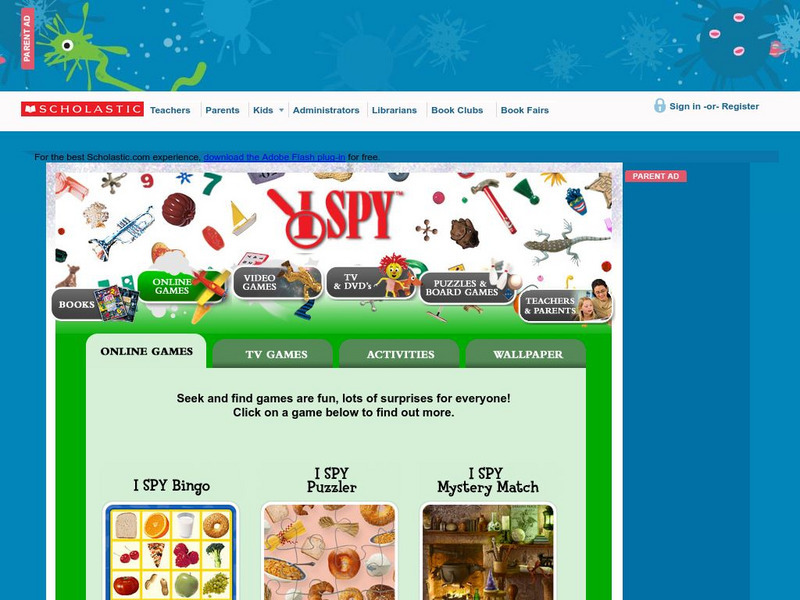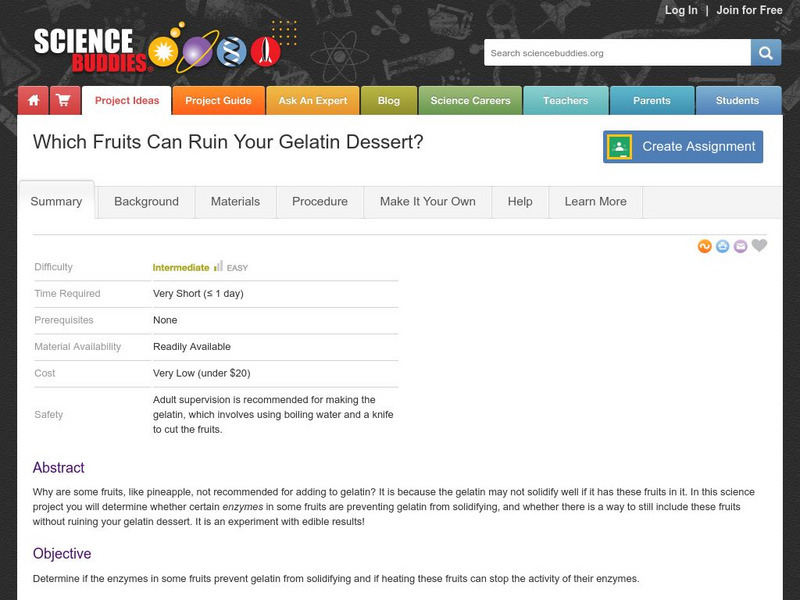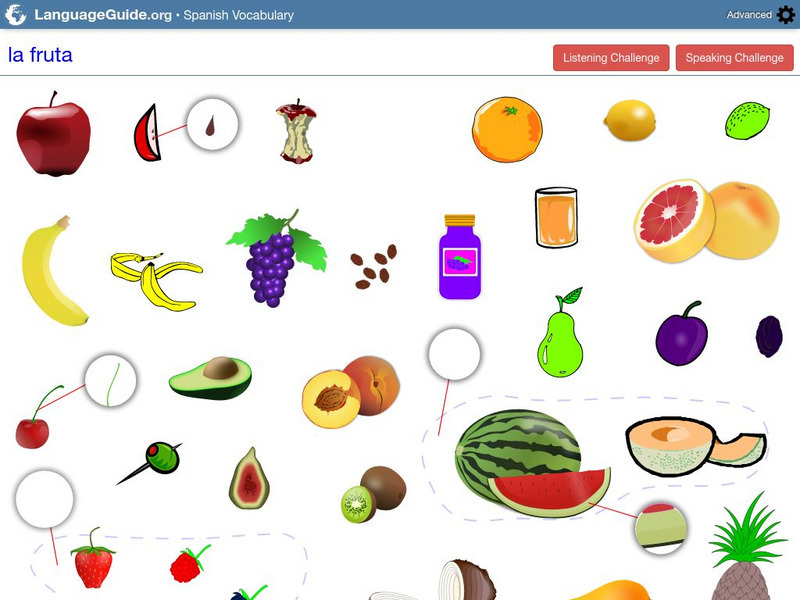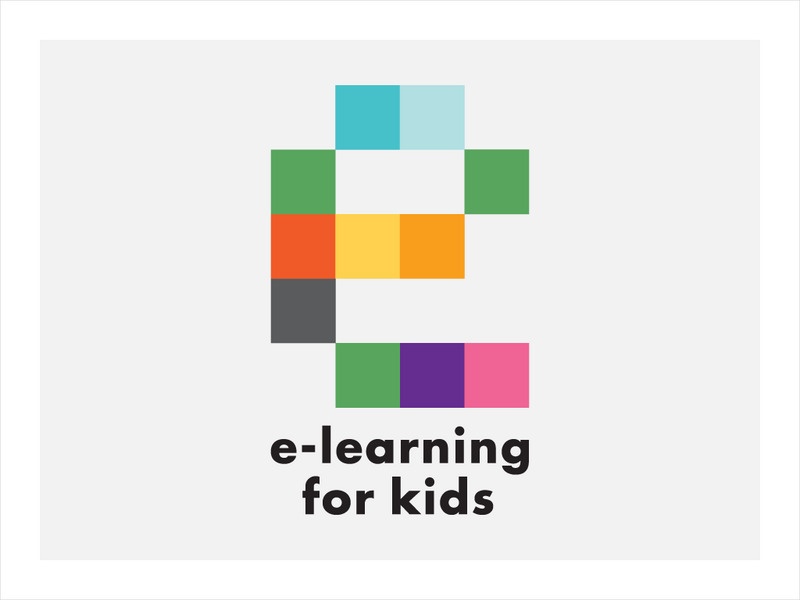Curated OER
Pigment Plucking
Pupils examine pigments found in different fruits and vegetables and practice the processes for extracting the pigments. Pigments are used to create artwork and a class PowerPoint presentation is made on the different types of plant...
Curated OER
Fruit Seeds
Second graders use fruit to conduct an observation experiment. They use the skills of observation to write down different facts about three different fruits looking at the outside and inside contents. Students explain two things they...
Curated OER
Give Me Five A Day!
Students engage in a lesson lead by the teacher to discover the diet plan of increasing the consumption of fruits and vegetables. They conduct discussions in class with each other, at home with parents, and in the community if possible.
Curated OER
Foods and Nutrition
Students are introduced to the names and colors of eight fruits. They participate in jazz chants, discuss favorite fruits, match vocabulary cards, complete a worksheet and write in journals.
Curated OER
Be A Food Explorer
Students read about and discuss the origin of many different fruits and vegetables. Students complete surveys, sample a variety of new foods and write about their reactions. They commit to trying at least three new foods.
Curated OER
Why Is An Apple Like A Suitcase?
Students examine a variety of fruit to discover that each has seeds. Through experimentation, they discover the role that fruit and seeds play in a plant's life cycle.
Curated OER
Natural Dye Lesson Plan
Young scholars investigate major pigments which occur naturally in fruits and vegetables, and to use them to dye a number of items. They study the effects of pH on anthocyanin on pigments.
Curated OER
What Are the Food Groups?
Students examine how eating a variety of foods keeps them healthy. They also explore how similar foods are grouped together in food groups.
Curated OER
Eating Fruit
Students select a piece of fruit from a central table. After some discussion on ways of representing form and proportions students record as accurately as possible, the entire fruit.
Curated OER
Nutrition: One Hot Topic!
Young scholars learn the content of the food groups and are better prepared to maintain a healthy diet and lifestyle. Students identify the main food groups and list content examples. Young scholars create a cookbook of new and healthy...
Scholastic
Scholastic: I Spy: Bingo
I SPY activities consist of software, jigsaw puzzles, and games for children. Students use problem-solving skills when playing the visual bingo. The bingo game examines food and fruit while learners look for a match.
University of Maryland
University of Maryland: Plant Biology
A webpage for a course on plant biology for non-science majors. The course covers how plants function, diversity among plants, and the roles of plants in the environment. Site includes lectures, a plant project, and a sample exam.
Science Buddies
Science Buddies: Which Fruits Can Ruin Your Dessert?
Here is a basic project for investigating enzymes that prevent gelatin from solidifying. This way you can understand why it is some fruits are not recommended for inclusion when it comes to making gelatin.
Science Buddies
Science Buddies: How Sweet It Is! Measuring Glucose in Your Food
You know that sugar makes food sweet. But did you know that there are different kinds of sugar? Sucrose is the granulated sugar that you usually use for baking. Another kind of sugar, which is found in honey and in many fruits, is...
Huntington Library
Huntington Library: Garden Lesson Plans: Why Is an Apple Like a Suitcase? [Pdf]
A mini-unit on fruits and seeds for younger learners. Students will learn that fruit is like a suitcase for seeds, and that together they help plants to reproduce. Includes ELL suggestions, extension activities, and worksheets.
Language Guide
Language Guide: Las Frutas
A fairly extensive listing of interactive pictures of fruits comes alive with audio to help students learn the correct Spanish pronunciation. Move the mouse over each picture to hear the word.
Ohio State University
Ohio State University: Plant Part Glossary
A useful resource for working with plants. Many illustrations enhance the clarity of the definitions, which can be accessed by clicking on the various links provided.
Science Buddies
Science Buddies: One Bad Apple Spoils the Whole Bunch: Plant Hormone Ethylene
We have all heard the old saying, "One bad apple spoils the whole bunch." Due to the production of the plant hormone ethylene during the ripening process, this saying proves true. This experiment will investigate the role of ethylene in...
Other
Western Growers Association
Western Growers Association is a group formed to give growers of fresh produce in California and Arizona support programs. Their homepage contains information about the organization, recipes, information on produce, news releases,...
Other
Mississippi Public Broadcasting: Ed Said
Meet Ed Said, a nine-year-old purple-haired hard-core fruit-and-veggie rapper. Learn nutrition facts from Ed by watching and playing his videos and songs. Includes many print-and-color activities about eating healthy fruit- and...
Centers for Disease Control and Prevention
Centers for Disease Control: Fruit and Veggies Matter
Learners explore fruits and vegetables. The activity includes a questionnaire that asks an individual's age, sex, and level of physical activity to determine the fruits and vegetables needed in an individual's diet. The resource consists...
Science & Plants for Schools
Science & Plants for Schools: Teaching Resources
A collection of teaching resources to help students explore plants! Resources investigate anatomy of plants, reproduction and life cycles, fruits, seeds, classification, photosynthesis, factors that affect plant growth, and respiration....
Biology Pages
Kimball's Biology Pages: Sexual Reproduction in Angiosperms (Flowering Plants)
This site, from retired Harvard professor John W. Kimball, provides a detailed but understandable explanation of sexual reproduction in flowering plants. Includes informative, well labelled illustrations.
E-learning for Kids
E Learning for Kids: Science: South Africa: What Are the Different Food Groups?
Join Sydney on his great island tour in South Africa, and learn more about the five food groups.
















![Huntington Library: Garden Lesson Plans: Why Is an Apple Like a Suitcase? [Pdf] Lesson Plan Huntington Library: Garden Lesson Plans: Why Is an Apple Like a Suitcase? [Pdf] Lesson Plan](https://d15y2dacu3jp90.cloudfront.net/images/attachment_defaults/resource/large/FPO-knovation.png)





